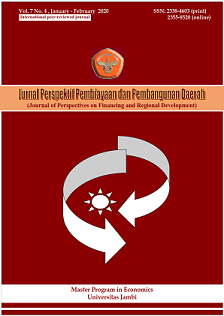Fiscal illusion as an incentive for local government public expenditure efficiency: The influence of community sensitization
DOI:
https://doi.org/10.22437/ppd.v7i4.8564Keywords:
Community sensitization, Expenditure efficiency, Fiscal illusion, Local governmentAbstract
Although the effect of public expenditure efficiency on local government fiscal performance is widely-documented, what precisely explains expenditure efficiency remains largely unclear. Nevertheless, past research holds fiscal illusion as the most likely predictor and community sensitization very critical for fiscal illusion-expenditure efficiency formation. We employed fiscal illusion theory to investigate possible fiscal illusion-community sensitization-expenditure efficiency mediation in 16 districts, 6 municipalities, and 160 sub-counties of Uganda’s northern region. Over the years, Uganda; an East African country, is applauded for its fiscal federalism proficiency. But presently, its northern region is grappling a 20-year post-conflict trauma likely to compromise entity spending efficiency. Structural equation modeling results suggest that all the four fiscal illusion constructs: fiscal imbalances, political divide, tax payment bias, and fiscal sabotage, predict changes in expenditure efficiency. However, community sensitization does not mediate the fiscal illusion-expenditure efficiency linkages. Implications for these findings and possible direction for future research are discussed.
Downloads
References
Afonso, A. & Fernandes, S. 2008. Assessing and explaining the relative efficiency of local government. Journal of Social Economics, 37, 1946-1979.
Blair, H. 2000. Participation and accountability at the periphery: Democratic local governance in six countries. World Development, 28(1), 21-39.
Cheung, G.W. & Lau, R.S. 2008. Testing mediation and suppression effects of latent variables: Bootstrapping with structural equation models. Organizational Research Methods, 11, 296-325.
Clemens, J. & Miran, S. 2012. Fiscal policy multipliers on sub-national government spending. American Economic Journal: Economic Policy 4(2), 46–68.
Congleton, R. D. 2001. Rational ignorance, rational voter expectations, and public policy: A discrete informational foundation for fiscal illusion. Public Choice, 107(1), 35-64.
Dell’Anno, R. & Mourao, P. 2012. Fiscal illusion around the world: An analysis using structural equation modeling approach. Public Finance Review, 40(2), 270-299.
Devas, N., Delay, S. & Hubbard, M. 2001. Revenue authorities: Are they the right vehicle for improved tax administration? Public Administration and Development, 21, 211-222.
Dollery, B. & Worthington, A. 1996. The empirical analysis of fiscal illusion. Journal of Economic Surveys, 10, 261-297.
Edwards, J. R. & Lambert, L. S. 2007. Methods for integrating moderation an mediation: A general analytical framework using moderated path analysis. Psychological Methods, 12(1), 1-22.
Ferrari, P. A. & Manzi, G. 2014. Citizens evaluate public services: A critical overview of statistical methods for analyzing user satisfaction. Journal of Economic Policy Reform, 17, 236-252.
Francis, P. & Robert, J. 2003. Balancing rural poverty reduction and citizen participation: The contradictions of Uganda’s decentralization program. World Development, 31(2), 325-337.
Gemmell, N., Morrissey, O. & Pinar, A. 2002. Fiscal illusion and political accountability: Theory and evidence from two local tax regimes in Britain. Public Choice, 110(3-4), 199-224.
Gupta, S. & Marijn, V. 2001. The efficiency of government expenditure: Experiences from Africa. Journal of Policy Modeling, 23, 433-467.
Guziejewska, B. (2016). Theoretical dimensions of fiscal illusions in local government finance. Journal of Economics, Business and Management, 4(3), 215-219.
Hooper, D., Coughlan, J. & Mullen, M. 2008. Structural equation modeling: Guidelines for determining model fit. Electronic Journal of Business Research Methods, 6, 1, 53-60.
Ketchen, D. J., Boyd, B. K. & Bergh, D. D. 2008. Research methodology in strategic Management: Past accomplishments and future challenges. Organizational Research Methods, 11, 643-658.
Mourao, P. 2006. The economics of illusion: A discussion based on fiscal illusion. Journal of Public Finance and Public Choice, 25(1), 96- 115.
Oates, W. 1991. On the nature and measurement of fiscal illusion: A survey. In Oates, W. Ed. Studies in Fiscal Federalism, Brookfield, VT, Edward Elgar.
Wagner, R. 1976. Revenue structure, fiscal illusion, and budgetary Choice. Public Choice, 25, 45-61.
Downloads
Published
How to Cite
Issue
Section
License
Copyright (c) 2020 Paul Onyango-Delewa

This work is licensed under a Creative Commons Attribution 4.0 International License.

















